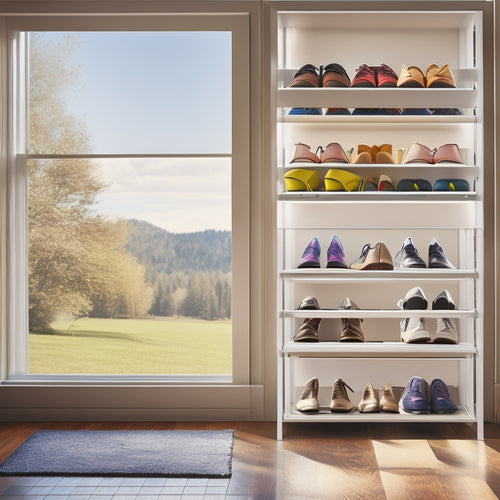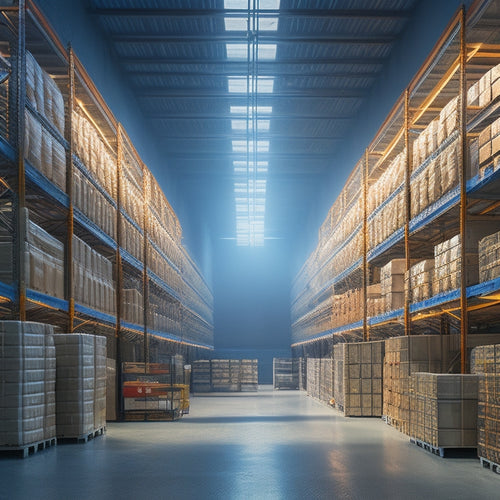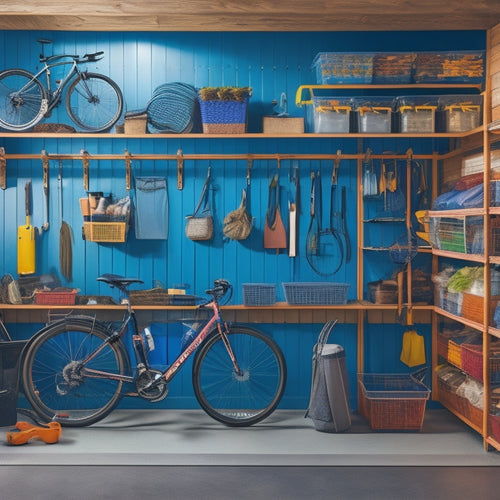Parts Bins for Workplace Efficiency
Share
By implementing a well-organized parts bin system, you can efficiently manage your workplace inventory, reduce clutter, and increase productivity by up to 30%. With the right bins, you'll reduce search time, maintain accurate inventory levels, and improve task completion speed. From small parts storage to stackable containers, and from labeling options to customization for your industry, there are many ways to tailor your system to your specific needs. By choosing the right bins and implementing effective storage strategies, you'll be able to access even more benefits and take your workplace efficiency to the next level.
Key Takeaways
- Organized parts bins enhance productivity by reducing search time, improving task completion speed, and promoting a safer work environment.
- Choosing the right bin size and material is crucial, considering factors like item size, storage space, and durability.
- Customization options, such as labeling and bin configuration, can be tailored to meet specific industry needs and improve organization.
- Implementing inventory management systems and optimizing storage space can help reduce costs, improve supply chain efficiency, and minimize delays.
- A well-organized workspace with designated areas, easy access to tools, and clear labeling can reduce stress, enhance safety, and promote productivity.
Benefits of Organized Storage
Implementing organized storage solutions in the workplace can greatly enhance productivity and efficiency. By categorizing and storing items in designated areas, you'll reduce the time spent searching for misplaced items and minimize the risk of accidents caused by clutter.
Organized storage also enables you to maintain accurate inventory levels, making it easier to identify and replenish stocks as needed. This, in turn, streamlines inventory management, reducing stockouts and overstocking.
Effective storage solutions also lead to productivity improvements. When items are easily accessible, you'll complete tasks faster and with less frustration.
You'll also reduce the likelihood of damaged or lost items, which can be costly and time-consuming to replace. Additionally, a well-organized workspace promotes a safer environment, reducing the risk of tripping hazards and other accidents.
Types of Parts Bins Available
You'll find that parts bins come in various styles to suit your specific needs.
For instance, you can use small parts storage bins to keep tiny components organized, or opt for stackable containers to maximize your storage space.
Additionally, you'll have labeling options to guarantee that each bin is clearly identified, making it easy to locate the parts you need.
Small Parts Storage
Frequently, small parts storage is overlooked, leading to cluttered workspaces and wasted time searching for misplaced components. You know how frustrating it's to spend hours looking for a single screw or nut. To avoid this, consider implementing a small parts storage system that suits your needs.
You have various options to choose from. Magnetic storage is perfect for tiny metal parts, while drawer organizers keep frequently used items within easy reach. Portable bins are great for projects that require multiple components, allowing you to carry them around easily.
Modular systems offer flexibility and customization, whereas clear containers provide visibility and ease of identification. Ergonomic design guarantees comfortable access, reducing fatigue and strain.
Additionally, anti-static bins protect sensitive electronics, and heavy-duty options withstand harsh environments. Color coding helps with inventory management, making it easier to track and restock supplies.
Stackable Containers
Efficiency takes a significant leap forward with the incorporation of stackable containers into your parts bin system. You can create a customized storage solution that adapts to your specific needs with these versatile containers.
-
Modular systems: Stackable containers allow you to build a modular storage system that can be easily expanded or rearranged as your inventory changes.
-
Durability features: Look for containers with reinforced walls, rust-resistant coatings, and heavy-duty bases to guarantee they can withstand the demands of your workplace.
-
Color coding: Use color-coded containers to categorize and prioritize inventory, making it easier to locate specific parts and reducing errors.
- Nesting capabilities: Choose containers with nesting capabilities to maximize storage capacity and reduce clutter when not in use.
When selecting stackable containers, consider the weight capacity, material options, and accessibility solutions that fit your specific needs.
Ergonomic considerations, such as handle design and lid accessibility, can also improve worker safety and comfort.
Regular maintenance, like cleaning and inspecting containers, will guarantee your system remains efficient and effective over time.
Labeling Options
A well-organized parts bin system relies on clear labeling to validate quick identification and retrieval of parts. You can choose from various labeling options to ascertain your parts bins are easily identifiable and accessible.
When it comes to label design, you have several options to contemplate. You can opt for a simple text-based label or a more complex design that incorporates images and color coding. Color coding is particularly useful for categorizing parts by type, size, or function, making it easier to locate specific items.
Here is a comparison of popular labeling options:
| Labeling Option | Description |
|---|---|
| Pre-Printed Labels | Labels with pre-printed text and images, ideal for common parts and components. |
| Blank Labels | Blank labels that can be customized with your own text and images, suitable for unique or specialized parts. |
| Color-Coded Labels | Labels with different colors to categorize parts, helpful for quick identification and retrieval. |
| Barcode Labels | Labels with barcodes for easy scanning and inventory management, ideal for high-volume parts and components. |
Choosing the Right Bin Size
When organizing your workspace, you'll often find yourself standing in front of a shelf or cabinet, wondering which parts bin size will best fit your needs. This decision can greatly impact your workspace efficiency and safety.
To choose the right bin size, consider the following factors:
-
Item size and quantity: Select a bin that can hold the desired quantity of items without overcrowding, guaranteeing easy access and minimizing the risk of accidents.
-
Storage space constraints: Measure the available shelf or cabinet space to confirm the bin fits comfortably, leaving enough room for easy retrieval and restocking.
-
Bin material selection: Consider the durability and resistance of the bin material to the items it will hold, as well as the environment it will be in. For example, bins in high-moisture areas may require rust-resistant materials.
- Bin color coding: Use colored bins to categorize and differentiate between various items, improving visual identification and reducing errors.
Labeling and Signage Strategies
Frequently, a well-organized workspace relies on clear labeling and signage to guarantee that parts and materials are easily identifiable and accessible.
You'll want to develop a labeling system that's easy to understand and follow. Start by using a consistent font and font size throughout the workspace. Consider implementing color coding to differentiate between types of parts or materials. For instance, you could use red labels for high-priority items or blue labels for frequently used parts.
Symbol usage can also be effective in conveying information quickly. You might use a symbol to indicate a part is fragile or requires special handling.
When creating labels, keep the text concise and focused on the essential information. You should include the part name, part number, and any relevant warnings or instructions.
Make sure labels are securely attached to the bins and are resistant to wear and tear. Regularly inspect labels for damage or fading and replace them as needed.
Customization Options for Industry
You're likely familiar with the importance of tailoring your parts bins to your industry's specific needs.
That's why you'll want to contemplate bin configuration options that allow you to customize the layout and design of your storage system.
Bin Configuration Options
In most cases, parts bins aren't one-size-fits-all solutions, and industries often require customized configurations to meet their specific needs.
You need a bin design that aligns with your industry's unique requirements.
When it comes to bin configuration options, you have several choices to guarantee your workplace runs efficiently and safely.
Consider the following customization options:
-
Color Coding: Use different colored bins to categorize and organize parts, making it easier to identify and access the items you need.
-
Bin Size and Shape: Choose from a variety of bin sizes and shapes to fit your specific storage needs, guaranteeing a perfect fit for your parts and tools.
-
Labeling and Signage: Customize your bins with labels and signs to clearly identify contents, reducing errors and increasing productivity.
- Divided Compartments: Opt for bins with divided compartments to separate and organize small parts, keeping them organized and within reach.
Industry-Specific Storage Needs
As you investigate the world of parts bins, it becomes clear that different industries have unique storage needs that demand customized solutions. The right parts bin can help you stay organized, efficient, and safe in your workplace. But what works for one industry may not work for another.
| Industry | Storage Needs | Customization Options |
|---|---|---|
| Automotive | Secure storage for small parts, easy access to frequently used items | Divided compartments, locking mechanisms, and mobile bins |
| Electronics | Protection from electrostatic discharge, precise control over component storage | Anti-static bins, compartmentalized storage, and ESD-safe materials |
| Pharmaceutical | Compliance with regulatory requirements, secure storage for sensitive materials | Temperature-controlled bins, secure locking mechanisms, and cleanroom-compatible materials |
For example, the automotive industry requires secure storage for small parts and easy access to frequently used items. In contrast, the electronics industry needs protection from electrostatic discharge and precise control over component storage. Meanwhile, the pharmaceutical industry must comply with regulatory requirements and guarantee secure storage for sensitive materials. By understanding the unique needs of your industry, you can choose the right parts bin to meet your specific requirements.
Improving Supply Chain Efficiency
Streamline your operations by pinpointing bottlenecks in your supply chain, where even minor inefficiencies can have a significant impact on your bottom line.
You can't afford to overlook areas where productivity is being hindered, as it can lead to delays, increased costs, and ultimately, a loss of revenue.
To improve supply chain efficiency, focus on the following key areas:
-
Inventory management: Implement a system that allows you to accurately track and manage your inventory levels, reducing stockouts and overstocking.
-
Supply chain optimization: Analyze your supply chain to identify areas where you can simplify processes, reduce transportation costs, and improve delivery times.
-
Vendor relationships: Develop strong relationships with your vendors to negotiate better prices, improve communication, and guarantee timely deliveries.
- Warehouse organization: Organize your warehouse to maximize storage capacity, reduce clutter, and improve picking and packing efficiency.
Reducing Workplace Clutter Stress
Beyond the supply chain, a cluttered workspace can be a significant productivity killer, and it's essential to tackle this issue head-on to reduce stress and improve overall efficiency.
You know how frustrating it's to spend hours searching for a misplaced tool or part, only to find it buried under a pile of clutter. By implementing effective clutter management strategies, you can free up time and mental energy to focus on more vital tasks.
Start by designating a specific area for each task or process, and make certain that all necessary tools and materials are within easy reach.
Labeling parts bins and storage containers can help you quickly identify what's inside, reducing the likelihood of misplaced items. By keeping your workspace organized, you'll reduce the stress that comes with clutter and create a safer, more efficient work environment.
By reducing clutter, you'll also reduce the risk of accidents and injuries caused by tripping hazards or falling objects.
With a clutter-free workspace, you'll be more productive, less stressed, and better equipped to tackle the challenges of your job.
Maximizing Storage Space Potential
You've optimized your workspace by designating specific areas for each task and labeling parts bins, but now it's time to raise your storage space to the next level.
To maximize your storage space potential, focus on utilizing your facility's vertical space. This is where vertical storage solutions come into play.
Here are 4 ways to maximize your storage space:
-
Install multi-tier shelving: Make the most of your ceiling height by adding shelves that can hold multiple levels of parts bins.
-
Use wall-mounted bins: Free up floor space by attaching bins to the wall, keeping frequently used items within easy reach.
-
Invest in stackable containers: Choose containers that can be safely stacked on top of each other, minimizing floor space usage.
- Implement a mezzanine system: Create a raised platform for storage, providing additional space without sacrificing floor area.
Frequently Asked Questions
Can Parts Bins Be Used in Outdoor or Harsh Environments?
You can use outdoor storage solutions made from weather-resistant materials to maintain organized outdoor spaces, ensuring your items remain protected and easily accessible, even in harsh environments, while keeping your outdoor organization system intact.
Are Parts Bins Compatible With Existing Shelving Systems?
You'll be blown away by the versatility of parts bins! They're designed to seamlessly integrate with your existing shelving systems, thanks to adaptable materials and clever design, ensuring a perfect fit and safe storage.
How Do I Clean and Maintain My Parts Bins?
You'll maintain a tidy workspace by regularly cleaning your bins; start by removing all contents, dusting with a soft brush, and wiping with a damp cloth, then reorganize contents by category for ideal bin organization.
Can I Use Parts Bins for Storing Hazardous Materials?
As you're handling hazardous materials, you're probably wondering if you can store them in parts bins. Be cautious, though - you can't just use any bin. Make certain you choose ones specifically designed for hazardous storage, complying with safety regulations to prevent accidents and contamination.
Are Parts Bins Available With Locking Mechanisms for Security?
You'll find bins with advanced locking mechanisms that provide excellent security features, ensuring restricted access to sensitive or controlled substances, and giving you peace of mind knowing your precious items are safely stored away.
Conclusion
As you gaze upon your newly organized workspace, a sense of calm washes over you. The chaos has subsided, replaced by a sense of control and precision. Your parts bins, once a tangled mess, now stand like sentinels, guarding your supplies and guiding your workflow. With every piece in its place, you're free to focus on the task at hand, your mind clear and your productivity soaring. The clutter is gone, and in its place, a sense of satisfaction and accomplishment takes hold.
Related Posts
-

Adjustable Modular Shoe Racks for Versatility
Adjustable modular shoe racks are your go-to solution for versatile and organized footwear storage. These racks maxim...
-

Heavy-Duty Commercial Rolling Shelving Racks
You need heavy-duty commercial rolling shelving racks that optimize your storage capacity, streamline operations, and...
-

Garage Wall Storage Ideas to Boost Productivity
You can enhance your garage's productivity by capitalizing on your ceiling height with overhead racks, storing bulky ...


